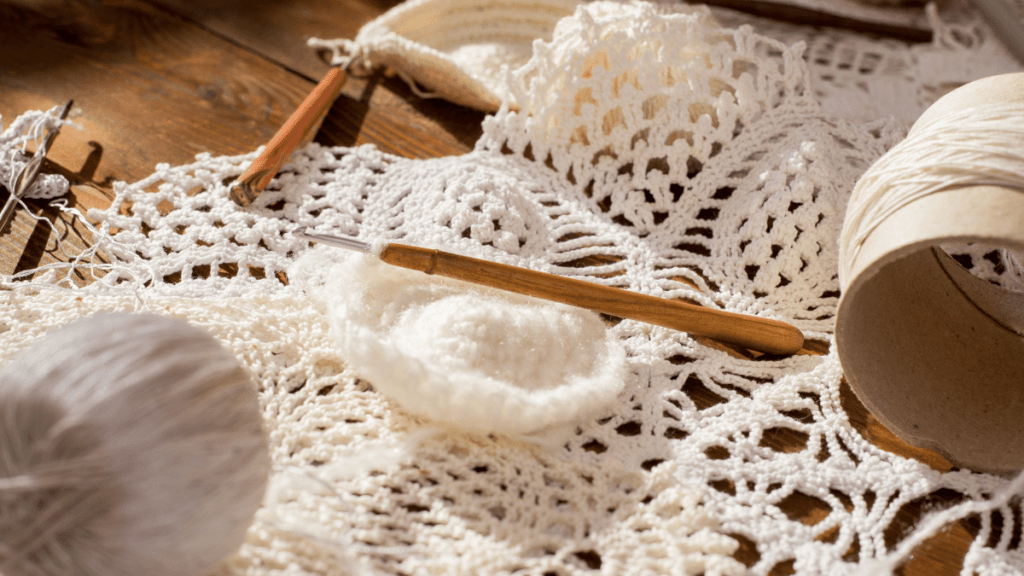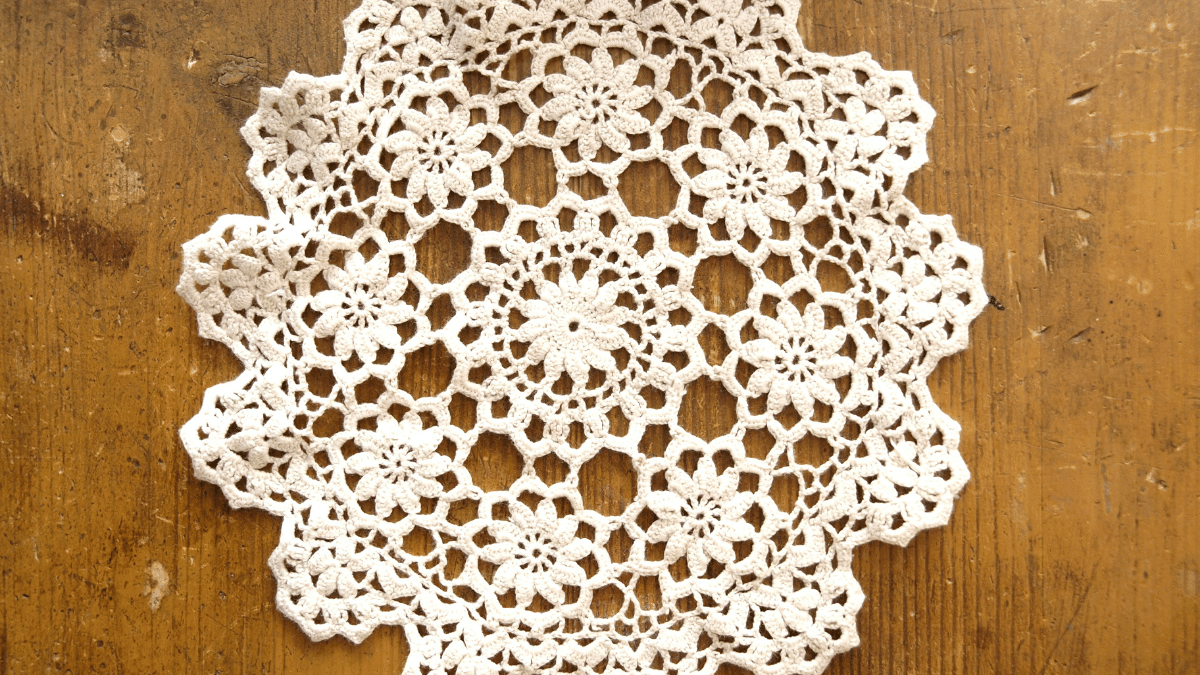
Got any crocheted doilies adorning your tables and centerpieces? They are often delicate and increasingly valued family heirlooms! Therefore, it’s only expected that – sadly – they sometimes get damaged. But, what should you do in that scenario? Should you keep them stored and never use them again? Or, should you take a deep breath and try to repair them?
Don’t panic – the knack to how to fix crochet doilies is easier to adjust to than you might think. You just need to exercise a little care and patience! If treated gently, the integrity of your doily can be completely restored. While much can depend on the age and condition of your specific doily in the first instance, there are still things you can try to bring your crocheted marvel back to life. Let’s dive in and take a closer look.
Getting started – be careful with colors!
Sadly, crocheted doilies both old and new can become easily damaged. With careful storage, even the oldest of doilies can survive the years – and may even retain their color. However, in many cases, you will need to be careful with color matches in order to conceal your repairs.
Unless you have a large array of yarn available – in various shades – it can be difficult to color match yarns. What’s more, if your damaged doily is old, it may have ‘yellowed’ over time.
Therefore, it’s sometimes easy to color match an older yarn with a modern one. For example, an old white yarn which has yellowed may be a closer match to a modern-day shade of cream.
If color matching is proving difficult, pop to a local hardware store and pick up a paint colors chart! These are generally free of charge and are ideal for referencing a color match for your doily.
Take your time to match the colors carefully – otherwise, you may end up hooking in yarn that really doesn’t look the part – and you’ll have to start from scratch. So, take it from me – prioritize color-matching with care!
Replacing central doily discs

Is your doily formed from a crocheted stitching surrounding a central disc of fabric? If so, you may need to replace that disc outright – carefully inspect the damage, and prepare your hooks! There are two ways to ‘attack’ this problem.
Firstly, replace the central disc entirely if you can be sure of attaching the crocheted stitching to a replacement. Replacing the disc with a new one, however, isn’t the big problem at stake. The issue will be to ensure you color match the yarn to repair a hole and rework the attachment to the disc. That, again, is why grabbing a color wheel or chart is so important!
Alternatively, if you can’t find a central disc of the exact same shade, it might be a good idea to consider choosing a contrasting shade! This means giving your doily a little bit of a different look, but you can easily reform the inner disc and any connecting stitches. Consider it a refresh of sorts for your old doily – and something of an invisible repair! Beyond refreshing the look, you’re giving your doily back a little more of its integrity.
Keep any yarn you may discard from a doily repair just in case! What’s more, if you have a set of doilies from the same source and/or era, the yarn may come in useful for further repairs.
Keep in mind, too, that older doilies may have been created with thinner, silkier yarns than we’d typically see nowadays. For a perfect color match, you may find it worth dying some yarn to form an invisible repair. This is extreme – but where family heirlooms are concerned, may be worth trying!
How to fix uneven doilies
If your doily’s having a bit of a wobble or seems uneven at either end, the great news is you can fix it without having to break out the hooks. Some can be easily restored to a smooth, even form, while others may require more delicate handling.
If a doily has become uneven it may be simply a question of how you’ve stored it. Sometimes, unless they are stored properly, doilies can become kinked. When doilies are folded in half or quartered, the folded creases set into grooves. These can be ironed out and yet still leave a distinct line – take note!
Start by gently washing your doily, or simply soaking it in lukewarm water. Avoid using hot water, as this may damage some fibers. Some doilies are made from multiple fibers, so be careful not to subject the whole item to too much heat!
Once soaked, you’re going to need to ‘block’ your doily. This means the doily should be placed on a towel or flat surface to slowly dry.
Another option is to gently steam the doily. By using an iron on low to medium heat, do not touch the doily with the base of the iron. Instead, hover the base of the steaming iron directly over the doily at a minimum distance of three or four inches above the fabric!
Once in position, give the doily a blast of steam, and then prepare to gently tease it back into shape.
Once again, lay it on a towel or other suitably covered flat surface and allow it to dry slowly.
How to handle easily creasing doilies
Older or fragile fabrics can be a nightmare to deal with – they’re often very soft or flimsy! However, sometimes – by adding fabric conditioner to rinse with water – you can condition the fibers of crochet doilies to help them regain some strength.
In addition, starching can be a temporary stiffener – you’ll need to coat the fibers of your doily in a fine application of starch diluted in water. This may be best applied from a spray bottle and delivered in a fine mist, prior to drying. Starch can change the feel of the fabric and in some instances reinforce it – it’s worth a try!
Fixing doily borders

Borders on doilies are sometimes formed by crocheted chains, or as part of an integral pattern where the outer edge is not attached to any other fabric or yarn. The good news is, crocheted edges of modern doilies may only require a quick fix!
A snagged thread may be unraveled back by a centimeter or two, and a new section can simply be stitched in. As always, you’re going to need to be careful matching your hook, yarn, and color while doing so.
Crocheted edges of older doilies, meanwhile, may be more delicate and a little more tricky to repair. Let’s take a look at two possible avenues for repair.
Repairing lost stitches
Remove any snagged, loose threads and reform a closed set of stitches by size matching a yarn and stitch. This means replacing only one or two stitches. It may include sealing a torn edge by a little more needlework. If you’re handy with stitching, you might find this technique a breeze!
Repairing torn edges
Torn edges, meanwhile, may require some stitches on the outermost lines – but others further inwards, too. This is going to take some work, though it’s best to work from the inside out. As above, the aim is to neaten any loose threads and remove damaged fibers.
If the damage is severe, it may be best to choose which side of your doily looks best face-up, and to apply some glue to the underside of the affected area. This may be a last resort – but it works!
After this type of repair, you should only ever hand wash the doily and check the glue remains in place. You may need to reapply it from time to time.
Conclusion
Fixing crochet doilies is a fine art – the above advice is just a taster of what to keep in mind, as doily damage really can vary in terms of size and scope! The best thing to do is take a deep breath and to treat those old doilies as gently as you can. Good luck!
Originally posted 2022-07-06 11:16:30.
